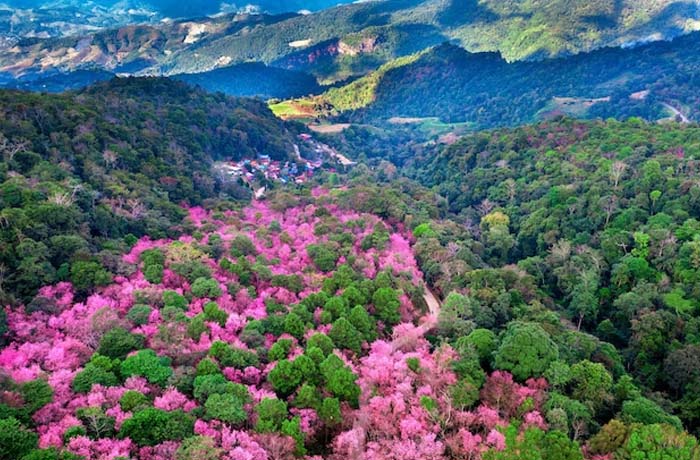
Leh – Valley Of Flowers – 4N/5D
Leh Ladakh
 Wifi
Wifi

Leh Ladakh
 Wifi
WifiLeh is a paradise of flowers and a visit to this place will be your most amazing journey. Explore this extraordinary destination for some soul-searching and leave the hassle of planning the trip to Unify Holidays.
DAY 01:- Arrive Leh
When you arrive in Leh, one of our employees will meet you, greet you, assist you, and transport you to a hotel. Take the remainder of the day off to acclimate to the high altitude of Ladakh and stay the night in a hotel.
DAY 02:- Excursion To Sham Valley (150 Kms Round Trip)
After breakfast, it's time to head for Alchi. Along the way, stop at the confluence of the Indus and Zanskar rivers, Magnetic Hill, and Gurudwara Patthar Sahib. After touring the Alchi Monastery, return by car to Leh. Before traveling to Leh, visit the Ladakh Hall of Fame. Once you reach Leh, fill yourself with dinner. After that, check-in at the hotel to stay overnight.
The full day tour will take you through the following places:
Gravity is defied by MAGNETIC HILL: This place is close to the Shri Patthar Sahib Gurdwara. The observation that a car slides uphill when stopped in neutral on this metal road is known as the "Believe it or Not of Ladakh."
GURDWARA SHRI PATTHAR SAHIB: Just outside of Leh town on the Leh-Srinagar Road. Constructed as a lasting tribute to the revered prophet Shri Guru Nanak Dev Ji, who blessed the site with his sacred visit during his second missionary tour (2nd Udassi 1515–1518) in 1517. Before coming here via Nepal, Sikkim, Tibet, Yarkand, and Leh, the Guru met and conducted spiritual discourses with the Siddhas on Mount Sumer (Central Himalayas).
On the hill, you can visualize features across the road where once lived a monstrous creature that terrified the inhabitants. Every day their problems got worse and worse. They begged God for help as their anguish became unbearable. It is said that after learning of their situation, the Great Guru stepped in to save them. On the edge of the nearby river, the guru took a seat. The Guru blessed the people and became well-known in the area when they begged for help. The indigenous people of the Central Himalayas referred to him as Nanak Lama.
The Demon was enraged and started planning schemes to kill Guru Nanak. One morning, as the Guru was meditating, he tried to kill him by rolling down a big boulder from the top of the mountain. But when Guru's flesh touched the solid rock, it melted like wax, and Guru's back sank into it like a cushion. The Guru went back to meditation undisturbed. When the devil showed in, he was astonished to discover the Guru in meditation and undisturbed, having assumed he had been killed.
In his wrath, he tried to push the rock with his right foot, but it had solidified into wax, and his foot got impaled on it too. He therefore realized his folly and powerlessness in the face of the spiritual grandeur of the Great Guru. He bowed himself down at the feet of the Guru and begged for pardon. The Guru gave him advice on how to stop his misdeeds and lead a moral life by helping people. As a result, Demon changed his way of life and started assisting others. The Guru then proceeded to Srinagar and Kashmir via Kargil on his sacred journey.
The Gurdwara still has a boulder that has the imprint of the Guru's back.
INTERSECTION OF THE ZANSKAR AND INDUS: There is a stunning view of two rivers joining together before Nimu hamlet on the way to Sham Valley. They vary in color, flow, and wildness with the seasons.
THE ALCHI GOMPA: Situated on the banks of the Indus, 70 kilometers from Leh, is the 1,000-year-old Alchi Gompa. On one of its walls are thousands of miniature images of the Buddha. Three large, vibrantly painted clay sculptures are its main drawings. Although it is no longer used as a site of worship, like monastery monks still care for it. This is the only monastery out of the thirty-four.
LADAKH HALL OF FAME: The Hall of Fame, which was constructed by the Indian Army, is a stunning museum. Every single citizen ought to visit such a place. You can view weapons, biographies, and images of prominent defense figures, as well as artifacts from the Kargil and other important strategic battles fought in Ladakh. The belongings of the opposing soldiers were also found at the scene of the fight, which includes every award for bravery and martyrdom...
"This will make you proud of our military personnel who gave their lives so we could live in peace."
DAY 03:- In Leh Sightseeing
This day is reserved for exploring Shankar, Shanti Stupa, Leh Palace, and taking a stroll through the local market in Leh.
VILLAGE OF SANKAR GOMPA: It is a very new monastery that shares close ties with the Spituk monastery. There resided Kushak Bakula, the late head priest. This area has a number of gold icons.
SHANTI STUPA (Japanese Peace Pagoda): The Shanti Stupa, also known as the Japanese Peace Pagoda, was constructed by a Japanese religious group headed by Head Monk Nakamura with aid from the organization and the neighborhood. Situated on a hilltop in the Changspa hamlet, it provides an aerial view of the surrounding mountain ranges and the town of Leh. Near the entrance lies the main Japanese shrine, and the architecture of the building is influenced by Japanese design.
LEH PALACE: After uniting upper and lower Ladakh and defeating Hor, King Tashi Namgyal built the Namgyal Tsemo, or victory peak. Then, to prevent more Hor invasions, their bodies were placed under an image of the guardian deity, Mahakala. The Leh palace known as "Lechen Palkhar" was built by Singay Namgyal sometime in the early 17th century A.D. The ASI (Archaeological Survey of India) is now renovating the nine-story palace, which is currently abandoned.
DAY 04 :- Excursion To Pangong Lake (280 Kms Round Trip)
Following breakfast in the morning, drive to Pangong Lake, which is close to the Chinese border. Once dinner is served, head back to your Leh lodging for the night.
THE PANGONG LAKE: This route leaves the Indus Valley by passing via the quaint villages of Shey and Thikse as well as the side valleys of Chemrey and Sakti. One of the easier crossings, the Chang-la (18,000 feet / 5,475 M) crosses the Ladakh range. With the exception of sporadic periods of actual snowfall, it is open all year round, even during the winter. Just past the foot of the pass, at Tangse, is an antique temple.
But the main draw for this route is the 14,000-foot (4,267-meter) Pangong Lake. Situated just seven kilometers from the lake's head, a long, narrow basin of inland drainage barely six to seven kilometers wide at its widest point provides a spectacular view of the Changchenmo range of mountains, with its reflection shimmering in the lake's brackish water's ever-changing blues and greens. Above Spangmik lies the summit of the Pangong range, crowned with snow and glaciers.
Day 5: Airport Departure.
After an unforgettable tour, depart on time for the airport in Leh to catch your departure. We are sure you had a wonderful time in the mesmerizing location.